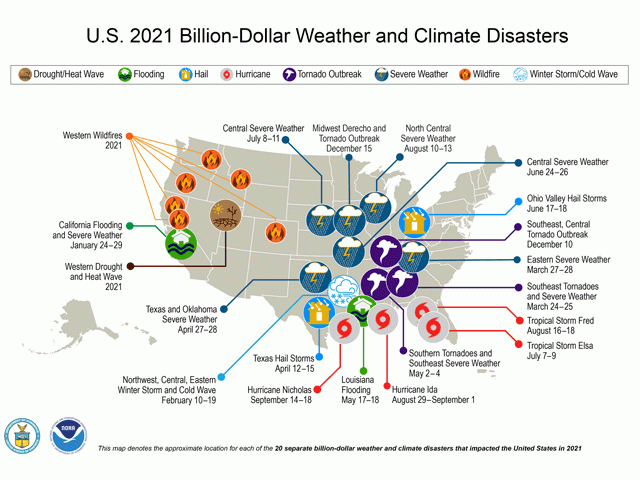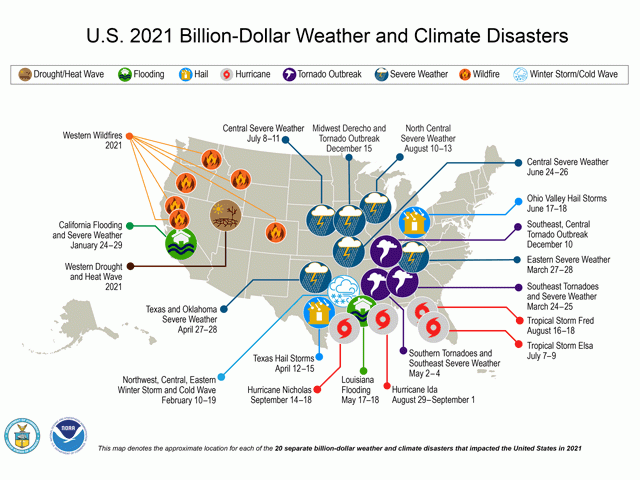Ag Weather Forum
Extreme Weather Costs Greater Than Farm Income
The number and cost of extreme weather events are astounding. The National Oceanic and Atmosphere Administration (NOAA) National Centers for Environmental Information (NCEI) reports that, in 2021, there were 20 separate extreme weather events in the U.S., which caused more than $1 billion in damage. The NOAA/NCEI report summary breaks down the events as follows: one drought event, two flooding events, 11 severe storm events, four tropical cyclone events, one wildfire event, and one winter storm event. The number of events is second only to 2020 when there was $22 billion in damage from extreme events.
The total cost in these events is $145 billion, the third costliest on record. There were 688 deaths because of these events. The NOAA/NCEI report also notes "significant economic effects on the areas impacted."
There are more staggering numbers. NOAA/NCEI reports that, since 1980, the U.S. has sustained 310 weather and climate disasters where overall damages and costs reached or exceeded $1 billion -- including Consumer Price Index (CPI) adjustment to 2021. The total cost of these 310 events exceeds $2.155 trillion -- about the size of Brazil's entire economy (gross domestic product, 2017). But more than one-third of that total has occurred in just the last five years -- 2017, 2018, 2019, 2020 and 2021. Damage from extreme events in the U.S. during this time period comes to $742 billion.
Here's how that extreme weather damage total compares to net farm income. The five-year total U.S. net farm income reported by USDA is just under $447 billion. That total is 40% less than the $742 billion total from extreme weather events in those years. Even the robust farm income number of last year, estimated by USDA in December at close to $117 billion, would still fall about 20% short of the $145 billion price tag from the extreme weather events.
P[L1] D[0x0] M[300x250] OOP[F] ADUNIT[] T[]
Figuring out the cause of these events is very straightforward in the scientific community -- continued warming. The average temperature in 2021 over the contiguous 48 U.S. states was 54.5 degrees Fahrenheit, 2.5 deg F above the 20th-century average and the fourth-warmest year on record (127 years). The six warmest years on record have all occurred since 2012. December was a new record-warm month; the contiguous U.S. average temperature reached 39.3 degrees Fahrenheit -- 6.7 degrees F above average and higher than the previous record-warm December in 2015. And behind the warming is the continued growth of heat-trapping greenhouse gas content in the atmosphere. The Rhodium Group, an independent research firm, reports that U.S. greenhouse gas emissions jumped 6% in 2021, mainly due to sharp increases in the use of coal along with a big increase in long-haul trucking.
NOAA climatologist and economist Adam Smith told DTN in an email of several surprises in the disaster occurrences last year; not that they happened, but the diversity and longevity of conditions to cause these events.
"The U.S. experienced most all types of extremes that NOAA's U.S. billion-dollar disaster analysis tracks," Smith said. "It was also surprising to have more extremes during December including the tornado outbreaks, the derecho and the Colorado wildfire. Another surprise was that these extremes produced the highest fatality count for the contiguous U.S. in a decade since 2011."
Smith also looks for the future to bring more of the same in terms of extreme costly and possibly deadly events.
"2021 is the seventh consecutive year (2015-2021) in which 10 or more billion-dollar weather and climate disaster events have impacted the United States. This trend is likely to continue," he said.
The full NOAA/NCEI report is available here: https://www.ncdc.noaa.gov/….
Bryce Anderson can be reached at Bryce.anderson@dtn.com
Follow him on Twitter @BAndersonDTN
(c) Copyright 2022 DTN, LLC. All rights reserved.






Comments
To comment, please Log In or Join our Community .